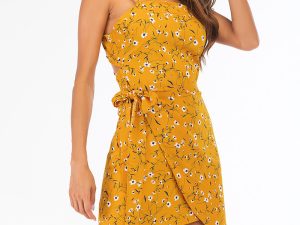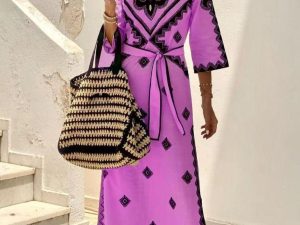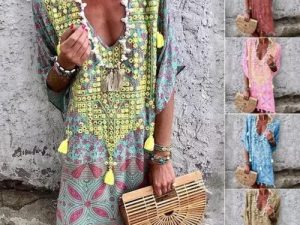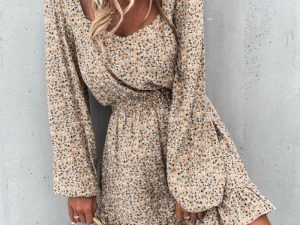Free shipping on all orders above $100
Dresses for Vintage Fairs: Must-Have Styles and Care Tips

Table of Contents
Shop Boho Dresses
If you’re gearing up for a vintage fair, finding the perfect dress is essential. Over at Boho 70, we’ve got a large selection of clothing that’ll make you the star of any retro event. Our dresses capture the essence of bygone eras, ensuring you stand out in authentic style.
The keyword “dresses for vintage fairs” isn’t just a phrase—it’s what we specialize in. Whether you’re channeling the flapper glamour of the 1920s or the bohemian vibes of the 1970s, our curated collection has something for every vintage enthusiast. Let Boho 70 help you find that perfect dress to make your next vintage fair an unforgettable experience.
Key Takeaways
- Find the perfect dress for a vintage fair by selecting from a variety of era-specific styles, from 1920s flapper dresses to 1980s bold and bright designs.
- Each vintage era has unique characteristics in dress design, fabrics, and details that will help you stand out at any retro event.
- Key accessories and appropriate footwear are essential to completing a vintage look; choose era-specific items to enhance your outfit’s authenticity.
- Know where to source authentic vintage dresses, such as thrift stores, online marketplaces, and vintage boutiques, to find a dress that captures your desired era’s essence.
- Proper care and maintenance of vintage dresses, including specific cleaning, drying, and storage techniques, are crucial to preserving their beauty and longevity.
Understanding Vintage Fashion
Vintage fashion captures styles from previous decades with authentic clothing and accessories. It comprises garments that reflect the trends of specific time periods, from the 1920s to the 1980s. Here, I’ll break down key elements for each significant era to help you navigate the world of vintage fashion.
1920s: Flapper Dresses
Flapper dresses often feature drop waists, fringes, and intricate beading. These dresses embody the Jazz Age’s vibrant energy and are perfect for achieving a Roaring Twenties look.
1930s: Bias-Cut Gowns
Bias-cut gowns of the 1930s exude elegance with their body-skimming silhouettes. These dresses typically include softer fabrics like silk or satin, creating a glamorous and timeless appeal.
1940s: Utility Clothing
Utility clothing from the 1940s reflects wartime influences, featuring simpler designs with more practical fabrics. Look for tea dresses with nipped-in waists and A-line skirts for an authentic 1940s appearance.
1950s: Full Skirted Dresses
Full skirted dresses of the 1950s highlight an emphasis on femininity and posture. Dresses with cinched waists, wide skirts, and bold patterns characterize this era’s iconic style.
1960s: Mod and Shift Dresses
Mod and shift dresses from the 1960s feature geometric patterns, vibrant colors, and simple lines. These dresses often include shorter hemlines and bold designs, reflecting the youth-driven cultural revolution of the decade.
1970s: Bohemian Chic
Bohemian chic dresses typify the free-spirited nature of the 1970s. Look for flowy, maxi-length dresses with earthy tones, floral prints, and eclectic detailing that embody the boho vibe.
1980s: Bold and Bright
Bold and bright dresses from the 1980s showcase exaggerated shoulders, vibrant colors, and striking patterns. These dresses often include bold prints, sequins, and ruffles, capturing the decade’s eclectic spirit.
Key Accessories for Vintage Fair Outfits
To complete any vintage fair outfit, consider adding era-appropriate accessories:
- Hats: Cloche hats for 1920s, pillbox hats for 1960s.
- Shoes: T-strap heels for 1920s, platform shoes for 1970s.
- Bags: Beaded clutches for 1920s, oversized bags for 1980s.
Choosing The Perfect Dress
Selecting the right dress for a vintage fair sets the tone for your entire experience. Whether it’s embracing the flapper style or donning a 1970s bohemian look, the perfect dress captivates and celebrates the era’s essence.
Consider The Era
- Research Key Trends: Each decade boasts unique styles. The 1920s have flapper dresses, while the 1960s offer mod and shift dresses. Focus on iconic elements like the dropped waistlines of the 1920s or A-line cuts from the 1960s.
- Select Representative Fabrics: Specific eras feature signature materials. For instance, cotton and wool dominate the 1940s due to wartime restrictions, while the 1970s highlight polyester and denim in their designs.
- Attention To Details: Era-specific features like the bias-cut of 1930s gowns or the bright, geometric patterns of 1980s dresses provide authenticity. Look for details like zippers, buttons, and embellishments that align with the time period.
- Inspect For Wear And Tear: Vintage dresses may show signs of aging. Examine areas around seams and hems for fraying or holes. Small imperfections may be acceptable, but extensive damage can detract from the overall appearance.
- Check Stains And Discoloration: Older fabrics can discolor, particularly around collars and underarms. Evaluate the fabric for stains, and consider whether they are treatable or permanent.
- Evaluate Fit And Alterability: Try on the dress to ensure it fits well or can be easily altered. Vintage sizes differ from modern ones, so alterations may be necessary. Check for ample seams and hems that allow for adjustments.
Popular Vintage Dress Styles
When attending vintage fairs, wearing the right dress style is crucial. Different era-specific styles offer distinct looks that can make you stand out. Here are three popular vintage dress styles.
Flapper Dresses
Flapper dresses, iconic in the 1920s, feature dropped waists and fringe detailing. These dresses typically include layers of beading and sequins. The loose fit and knee-length hemline make them comfortable for dancing. Pair them with T-strap heels and a cloche hat to complete the look.
Swing Dresses
Swing dresses, popular in the 1950s, are known for their full skirts and cinched waists. Oftentimes, these dresses have bold patterns and bright colors. Swing dresses enhance an hourglass figure and are ideal for twirling on the dance floor. Accessories like petticoats and cat-eye sunglasses complement this style.
Maxi Dresses
Maxi dresses became a staple in the 1970s with their floor-length design and flowing fabrics. These dresses often feature floral prints and bell sleeves. Perfect for a bohemian look, maxi dresses can be paired with wide-brimmed hats and platform shoes.
Where To Find Authentic Vintage Dresses
Finding authentic vintage dresses for vintage fairs takes effort, but it’s rewarding. Here are the top spots to score timeless pieces.
Thrift Stores
Thrift stores offer a variety of vintage dresses at affordable prices. Explore Goodwill or Salvation Army locations, which often carry hidden gems from past decades. Large cities usually have a higher turnover of goods, increasing your chances of finding unique items. Inspect dresses for authenticity by checking labels and fabric quality.
Online Marketplaces
Online marketplaces have made it easy to find vintage dresses. eBay and Etsy feature sellers who specialize in vintage clothing, ensuring a wide selection of dresses from different eras. Check seller reviews and product descriptions to avoid replicas. Another good option is Depop, where users list pre-loved fashion items. Filters help you narrow down specific styles and eras.
Vintage Boutiques
Vintage boutiques offer curated collections of authentic dresses. Visit local boutiques in your area or popular ones in major cities. These shops often have knowledgeable staff who can guide you in finding the right dress for your era of choice. For a premium selection, consider boutiques like Recess in Los Angeles or What Goes Around Comes Around in New York City.
To find a huge selection of chic clothing, visit our online store, Boho 70. We’ve got a broad range of dresses to help you stand out at any vintage fair.
Tips For Styling Vintage Dresses
Styling vintage dresses for fairs requires attention to detail to capture the essence of the era. Here are some essential tips to help you stand out.
Matching Accessories
Incorporating accessories enhances a vintage look.
- Jewelry: Choose era-specific pieces like pearl necklaces for the 1950s or chunky bracelets for the 1980s.
- Bags: Select bags like beaded clutches for the 1920s or structured handbags for the 1960s.
- Hats: Opt for cloche hats from the 1920s or wide-brimmed hats from the 1970s to complete the outfit.
Proper Footwear
Footwear can make or break a vintage look.
- Heels: Wear Mary Jane shoes for a 1930s vibe or stiletto heels for a 1960s feel.
- Boots: Choose knee-high boots for a 1970s ensemble or ankle boots for a 1940s appearance.
- Flats: Ballet flats suit 1950s style, while loafers work well for a 1960s mod outfit.
Hair And Makeup Tips
Recreate authentic looks with the right hair and makeup techniques.
- Hair: Style finger waves for a 1920s look or a beehive for a 1960s vibe. Use hairspray for long-lasting hold.
- Makeup: Apply red lipstick and winged eyeliner for a 1950s look or bold eyeshadow for a 1980s vibe. Use era-specific products to achieve the right effect.
Caring For Your Vintage Dresses
Proper care keeps vintage dresses looking great. It’s essential to follow specific cleaning and storage guidelines to preserve their beauty.
Cleaning Tips
- Hand-Wash Delicate Fabrics: For silk, lace, and other delicate materials, hand washing is safest. Use a mild detergent and lukewarm water. Soak the dress for about 5-10 minutes then rinse gently.
- Spot Clean When Possible: For minor stains, spot clean instead of washing the entire dress. Use a soft cloth with a mild detergent solution. Dab, don’t rub, to avoid damaging the fabric.
- Dry Cleaning: If unsure about the fabric, take the dress to a professional cleaner that specializes in vintage clothing. This ensures proper care without the risk of damage.
- Gentle Drying: Never use a dryer for vintage clothing. After washing, lay the dress flat on a towel and roll up to remove excess water. Then, lay flat on a drying rack away from direct sunlight.
- Use Padded Hangers: For structured dresses, padded hangers help maintain the shape. Avoid wire hangers which can distort the fabric over time.
- Proper Folding: If the dress is too delicate to hang, fold it carefully. Use acid-free tissue paper to wrap the dress, placing tissue between folds to prevent creases.
- Avoid Plastic Covers: Store dresses in breathable garment bags. Avoid plastic covers which can trap moisture, leading to mold and mildew.
- Cool, Dark Place: Store dresses in a cool, dark place to avoid exposure to light and heat. These elements can cause fading and weakening of the fabric over time.
Explore a huge selection of vintage chic clothing at our online store, Boho 70. Find unique vintage style dresses perfect for every vintage fair. Visit Boho 70 today for authentic vintage fashion that stands out.
Conclusion
Vintage fairs offer a magical journey through time and fashion. Whether you’re drawn to the elegance of the 1920s or the boldness of the 1980s there’s something uniquely captivating about vintage styles. Authenticity is key and with the right dress and accessories you’ll stand out with your individual flair. Remember to care for your vintage pieces properly so they can continue to shine for years to come. For a curated selection of stunning vintage dresses check out Boho 70’s online store. Embrace the charm of yesteryears and let your style tell a timeless story.









